Here’s how private a person the celebrity chef with the very un-private life really, truly is.
Jamie Tran downs a shot of tequila, one of her go-to spirits, tucked into a corner of the bar, sitting beneath walls she helped paint. It’s 6:30 p.m., 11 hours after her workday began, buying groceries at the market, with another three or four to go, as usual.
Then she shares an anecdote that goes something like this: One of Las Vegas’ hottest chefs, who’s currently a finalist for a James Beard Foundation Award (the restaurateur equivalent of an Oscar nod), who’s fresh off of becoming a fan favorite on the compulsively bingeable reality competition TV show “Top Chef,” who owns an acclaimed restaurant bringing innovative French-influenced Vietnamese American cuisine to a new part of town — Strip be damned — didn’t even tell one of her older brothers that she had opened her own place.
Said place: The Black Sheep, a restaurant as evocative of their shared upbringing as their shared DNA, a restaurant named after Tran’s role as the headstrong, mouthy kid among her eight siblings.
“I waited until a year after to even say anything,” Tran says, semi-sheepishly. “I felt like, if you talk about your stuff in the beginning and you don’t make it … I didn’t want to be embarrassed.” 
Brother only found out while in town for a baby shower, when the gathering was short on ice.
Tran took to him The Black Sheep to grab some.
He thought she just worked there.
“He was like, ‘How funny, you’re working at The Black Sheep, when you’re the black sheep,’ ” she recalls with a smile, because she recalls most things with a smile. “I was like, ‘Shut up.’
“And then later on, he looked at The Black Sheep and he looked at me, he looked at The Black Sheep and he looked at me, he said, ‘This is your restaurant?!’ ” she continues. “He was like, ‘Oh, my God, why didn’t you say anything? I’m so proud of you, blah, blah, blah.’ And I was like, ‘Ewww, shut up, let’s just get ice.’ ”
Though she’s a burgeoning culinary star, Tran still deflects attention like a tennis pro returning serve — even from some family members. While we’re on the subject of being the center of attention, she’s never really been all that into the obligatory chef chore of working the room, dropping the expected payload of pleasantries. 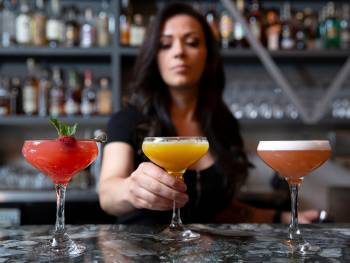
And so Tran plays it cool, bantering with her bartender as guests filter in a little more slowly than usual.
“She makes work fun,” contends mixologist Erin Hall, a tattooed former patron turned employee.
“No, I don’t,” Tran shoots back.
“Yes, you do,” Hall returns fire, combating sass with sass.
“Go to hell, Er,” Tran counters in a cartoon voice (She employs many of them). “You’re too nice. (Laughs). You’re making me uncomfortable (Bigger laugh). I don’t take compliments.”
Are you starting to understand how Jamie Tran earned that whole “black sheep” designation?
Now, if Tran’s an unlikely/borderline begrudging public figure, The Black Sheep qualifies as an unlikely culinary hot spot — especially in terms of location.
Nestled in a strip mall on the southwest side of town, vying for your hard-earned dinner dollar with a neighboring Roberto’s Taco Shop and Jersey Mike’s Subs, The Black Sheep is one of the engines powering a relatively new development in Vegas dining: chef-centered, off-Strip restaurants opened in parts of town where, you know, people actually live.
“Las Vegas was very slow to adopt independent restaurants that are chef-driven because all the talent in Las Vegas was going to the Strip, where both of us trained, for 30 years,” says her friend and fellow chef James Trees, owner of downtown’s Esther’s Kitchen and Summerlin’s Al Solito Posto. “Because of that, we’re just a very immature restaurant community. But what we found was that people were craving uniqueness, technical difficulty, some passion in their food.
“And Jamie embraces the technique aspect and the passion aspect of independent restaurants in a major way at Black Sheep,” he continues. “I think that’s something that can’t be underlined enough, because it wouldn’t be the first choice of any chef to be like, ‘I’m going to go open a French-Vietnamese restaurant that’s Western-leaning in the southwest area.’ ”
What she embraces far less?
Credit for doing so.
To put it her way: Ewww, shut up. 
Small space, big things
“Most people’s kitchens don’t look like this.”
If understatement could kill, Jamie Tran would be getting fitted for a toe tag, presently.
It’s just past 5 p.m. on a Tuesday, which means dinner’s on and the oven’s off at The Black Sheep.
It’s tight in here, 300 square feet tops; that’s about the size of one of the walk-in freezers at the big Strip restaurants like Aureole at Mandalay Bay and at DB Brasserie at The Venetian, where Tran cut her teeth in Vegas after relocating here to attend the Le Cordon Bleu College of Culinary Arts in 2010.
The Black Sheep kitchen symbolizes Tran’s career: You’ve got to think outside the box to make a space like this work, make the most of limited ingredients, which is the exact same thing she does with the Black Sheep menu.
There’s definitely no room for a walk-in freezer here — which means food supplies have to be bought daily; Tran’s mornings often begin at Asian markets at 8 a.m. followed by a stop at their Korean counterparts when they open at 9 a.m. — nor any heat lamps or dishwasher.
There’s no separate fish station, meat station or dessert station, each manned by multiple people, which you’d find at larger restaurants.
Instead, it’s just Tran working a six-burner grill — one burner of which never seems to work right — flanked by tonight’s line cook, Miguel Rodriguez.
Pretty much everyone and everything in here must serve multiple purposes.
Hence, the idle oven.
“During service, we turn that off and use it as a plate warmer,” Tran explains.
This means that no dishes get started until the order has been placed and the meal ticket is in — steaks, for instance, can’t be seared and stashed to later be cooked quickly when someone wants one, a common practice where there’s more ample storage space.
This also means that things can get real frenetic, real quick around here.
“People who come from the Strip and bigger kitchens, they usually don’t last, because it’s overwhelming for them,” Tran says. “Other places, you’ll still get overwhelmed by all the tickets, but you have your own space, you have your own four or five items that you’re working on and that’s it.
“Here, you have to work on more than four or five items,” she continues. “I have to crank it out.”
Tran and Rodriguez move like different fingers on the same hand, working in unison, a choreography of confined space.
It’s like a symphony where the conductor also plays half the instruments or an office where 22 workers share one cubicle.
The frenzied pace has only accelerated since “Top Chef” elevated The Black Sheep from a successful business to a booming one.
“It’s much different,” notes veteran server Shepherd McFarlane. “It’s usually busy from the beginning all the way to the end. I remember before ‘Top Chef,’ if the Golden Knights were playing, we’d serve like 30 guests, and that would be it.
“Now, it’s lots of people,” he adds. “Lots of people coming from the Strip and from other places, and coming in specifically because they saw her on ‘Top Chef.’”
“Order in!” Tran announces, as she works three dishes on the grill while Rodriguez hands her a platter of neatly aligned quail eggs.
Rodriguez was hired as a dishwasher, but like everyone else here — Tran included — he’s had to learn how to fill numerous roles. Now, he preps food and cooks on the line as well.
When he first landed the job, he had no idea who his new boss was.
“Then when they told me, at the beginning. I was a little nervous working with her,” he acknowledges, “because, you know, I’ve worked at different restaurants, but it was never where somebody was big.”
“I’m not big,” Tran says. 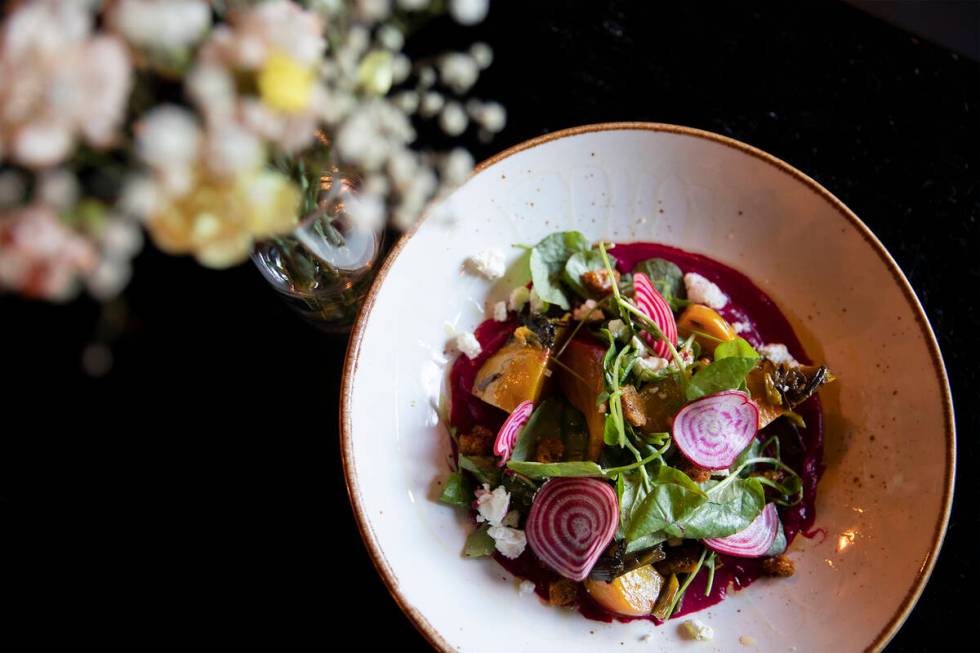
All in the family
Food possesses a remarkable power to render us all time travelers, doesn’t it?
Everyone has that dish that transports them to back to childhood more quickly, more powerfully, than flipping through the pages of an old photo album, even.
Mine is the porcupine meatballs my late father made — I can summon their rich, tomato-y flavor instantly, despite not having tasted them in 25-30 years now.
It’s science: The hippocampus, the part of the brain responsible for the creation of long-term memories, possesses receptors for the hormones that regulate our eating behaviors.
This rings palpably true for Jamie Tran: Her cooking is a wormhole to her girlhood, dating to back when she was 4 years old and her mother — tired of her daughter’s constant begging one morning — slid a blue milk crate in front of the stove of their Stockton, California, home for Tran to sit down on and cook some fried rice.
It was the first dish she ever made.
“A lot of Southeast Asian families, we’re not very expressive, you don’t say ‘I love you’ a lot and stuff like that,” Tran says. “My mom — she did hugs and stuff like that — but I think food was more her way of showing us that she loved us. I realized at a young age that you can express yourself through food.”
Her cooking has doubled as a vehicle for that expression ever since.
One of her favorite sayings, something you’ll undoubtedly hear if you’re around her long enough: “That’s me on a plate.”
OK, so who is Jamie Tran?
In the kitchen, she’s an amalgamation of mom (Tho Nguyen) and dad (Canh Tran).
He was a chef himself — a former military man with a suitably militant disposition, the kind of no-nonsense, dedicated father who gets up early each morning to lead his kids in kung fu sparring sessions.
He was a demanding, exacting man, a taskmaster obsessed with precision, a scalpel.
Things need to be done a certain way, the right way. My way.
Tran learned technique and discipline from him.
Her mother, in many ways, was the opposite, a welcoming, intuitive presence who didn’t measure ingredients when cooking; she was kind and creative, a paintbrush.
Come pick herbs with Mom.
Tran learned artistry and a love of experimentation from her.
Both of her parents are natives of Vietnam — though Dad has some Chinese in him as well — who escaped to Korea during the Vietnam War before eventually settling down in California, where Tran was born.
Tran’s not traditionally Vietnamese, and her cooking style — “Vietnamese-influenced, French technique with American ingredients,” as she describes it — reflects this.
It’s the geography of her upbringing on a plate.
“She cooks from the heart, and that’s what cooks should be, that’s what chefs should have: heart,” says Maria Mazon, a fellow contestant on “Top Chef” who’s the executive chef and owner of BOCA Tacos y Tequila in Tucson, Arizona. “Let your imagination, let your memories, let your childhood come out in a more refined way.
“I think the menu of The Black Sheep, it’s a letter to her family,” she continues, “it’s a letter to herself, it’s a letter to Vegas, it’s a letter of not being apologetic and just cooking from, literally, your heart.” 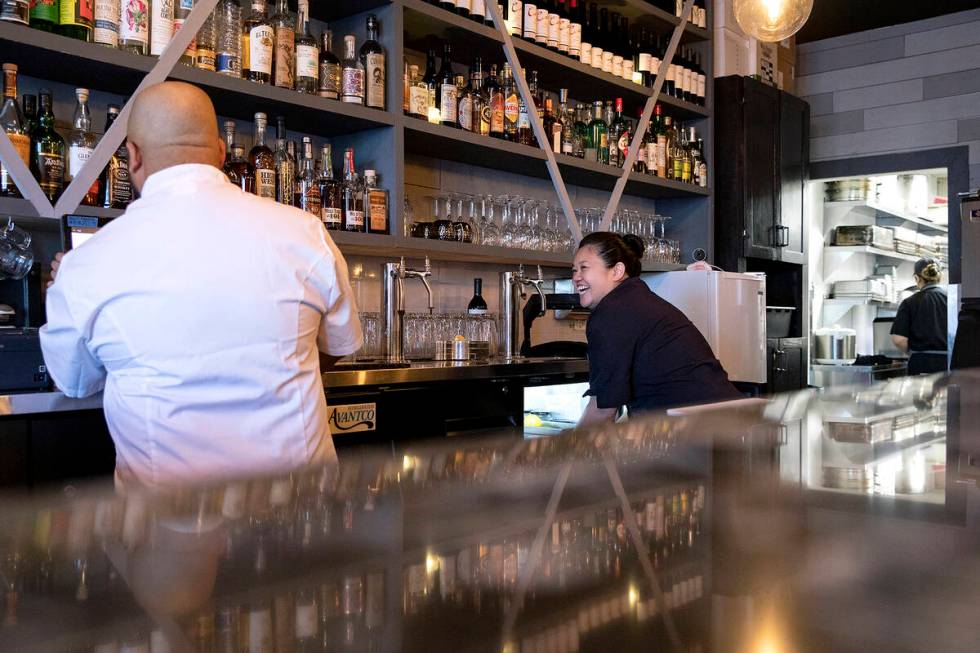
‘Face it, Slimy, you’re going to be a chef’
While each parent figures prominently into the chef that Tran has become, the Black Sheep menu has always been a love letter to Mom.
Take one of its more popular items, the Imperial Rolls, a blend of duroc pork and shrimp, pickled heirloom carrots and radish and yellow frisee salad.
“I remember growing up eating it,” Tran says. “My other Vietnamese friends would say, ‘What is this? This is weird,’ because I guess their parents are from another area of Vietnam, so they didn’t have that. I got made fun of, because they didn’t know what it was. But I didn’t care. I loved it. And people love it, too.”
Same for another guest favorite, the Bao Sliders, two homemade pork sausage patties topped with fried quail egg, shallot, herbs and jalapeño aioli.
“I grew up making it with my mom,” Tran says. “Vietnamese people, we have, like, those instant bao dough powders. I remember we ran out of it, and I wanted to make it, so I made up my own steamed bun — put this in, put that in. I kept on testing things in the kitchen; I think this was my sophomore year in high school.”
It was around this time, when Tran was 14, that she joined Dad in the kitchen at the Mandarin restaurant where he was working, to wash dishes and earn money for volleyball and basketball gear. Before long, she was jumping on the line, sneak-cooking to the irritation and disapproval of Dad, who didn’t want his daughter to be a chef.
And she didn’t either — at least not at first.
Quick rundown of the various occupations Tran pursued, in order, as an undergrad at San Francisco State University: doctor, physical therapist, orthopedic surgeon, optometrist, CPA.
Fittingly, it was a call from an older brother — who, in true older brother fashion, refers to her by the pet name of ‘Slimy’ — that helped convince Tran to accept her fate.
“He was like, ‘Face it, Slimy, you’re going to be a chef like Dad,’ ” Tran recalls. “My friends would all tell me, too, ‘You’re a chef. I don’t understand why you keep doing all this other stuff.’ I was like, ‘OK.’ ”
There was one self-imposed stipulation.
“I was like, ‘If I’m going to be a chef,’ ” Tran recalls, “I’m going to own my own restaurant.’ ”
She gave herself 10 years to accomplish said feat after earning her degree in business management.
She did it in seven, opening The Black Sheep in 2017 in the southwest part of town, where her founding partners Andy Hooper and Jon Schwalb lived, leaving behind the grind of the Strip, where she says she toiled 18 hours a day at times. At Aureole and DB Brasserie, she worked under chef Vincent Pouessel, whom she considers her mentor.
“It still kind of impresses me to this day that she was able to transit everything that she did with me to her own restaurant — she just made it herself,” Pouessel says. “She has the ability to soak it up and make it her own. I think that’s what makes her different than most of the chefs that I work with.”
A (reluctant) star is born
She looked like she didn’t really want to be there, and that’s because she really didn’t.
After producers contacted her to compete on “Top Chef: Portland,” friends had to convince a reluctant Tran to take part in the show — competitions are not her thing; they goose her anxiety.
Even then, she didn’t have high expectations.
“I think I’m just going to try to get eliminated on the second episode,” Tran recalls telling a buddy. “I won’t be the first one (eliminated); I’ll be the second one, and I think I’ll be fine.”
You could see her obvious nervousness during the series’ first episode, where she had the look of someone struggling to defuse a ticking time bomb as opposed to cooking shrimp and grits.
But she quickly became a fan favorite on the show, ultimately finishing fourth, for her penchant for making silly sound effects and thorough lack of the de rigueur reality-show cattiness. 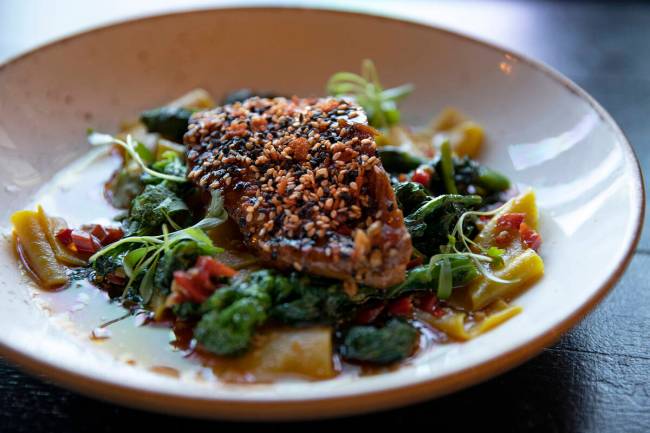
When she was cut after the fifth episode, only to make it back to the series after winning on “Last Chance Kitchen,” Tran’s would-be rivals were elated at her return.
“I’ve never seen a group of chefs so excited to see another competitor,” show host Padma Lakshmi noted.
Tran was eventually eliminated from the show in the second-to-last episode of the season for doing the very same thing that’s made her a success: being a curveball incarnate.
To wit: She made an ambitious attempt at a fish-and-cheese entree that’s every bit as left field as it sounds. But fish is one of Tran’s loves, and if she was going to go out, she was going to go out being herself.
“Of all the dishes today, you had the most ambitious ideas,” one judge noted.
“Your dish came from outer space,” another marveled.
In the end, it was deemed too out-there by the majority of judges and Tran’s run was over.
Then she made a joke about cutting the cheese and left.
On fame and well-fed dogs
Jamie Tran sings a lot when she’s tired. Or stressed.
She doesn’t know why.
“I don’t sing well at all,” Tran confesses.
But sing she does, favoring old-school R&B. Think Mariah Carey, Boyz II Men, Whitney Houston.
She doesn’t even always realize she’s doing it.
A friend told her that it was her way of coping with being in a chaotic environment.
That chaos has only increased following her tenure on “Top Chef” with an even busier restaurant and increased demands on her time.
“ ‘Top Chef’ made it different,” Tran says. “I couldn’t be in front anymore. People would just put their phones in my face and want my picture and I’m like, ‘I’m working right now.’ My anxiety went up. I felt people staring at me. I think I got a little better now.”
Since the show, she’s been traveling more, having dinner events with some of her fellow “Top Chef” contestants. She cooked with Louya in Detroit in May and is doing the same with Mazon in June in Tucson.
Later in the year, all 14 of the former competitors will meet up and cook together in Boulder, Colorado.
When in town, Tran prefers to be a homebody.
She lives with her younger sister and her 4-year-old niece, whom she’s already teaching how to cook the same way her mother taught her.
They recently adopted a puppy, whom Tran feeds with homemade meals, of course.
“The puppy doesn’t eat doggy food,” she says. “I made her dumplings the other day. I make rice and corn for her. I shred cowtail pork in there.”
Tran enjoys the outdoors — she was freshly sunburned from hiking at Mount Charleston during her final Skype interview with the producers of “Top Chef” prior to officially being selected to join the cast — but she hurt her knee one day on the job and hasn’t been able to be as physically active since.
At The Black Sheep, she’s trying to better balance her work life and personal life, encouraging her staff to take the reins a bit more.
“I want to empower people to start running on their own,” she says. “I see myself trying to focus more on ownership, being the owner, instead of me being on the line all the time.
“I’m doing both,” she adds. “I’m tearing myself apart.”
‘The time of the independent restaurant’
Aside from the cutlery, just about everything here is made from scratch: the steam buns, steam cakes, turmeric noodles, naan bread, scallion pancakes, even the syrups for the cocktails — which Tran also helped create — and the ice cream.
“I like to do everything from scratch, but it’s kind of hard on the prep cooks,” she acknowledges. “I realized, I gotta reel it back.”
Her grand compromise: She buys the shrimp chips.
So much of the menu is homemade, with recipes unique to Tran, dining at The Black Sheep is an experience you can only have at The Black Sheep, because it’s a direct, idiosyncratic reflection of who Tran is and how she was raised.
Whether the food resonates with your taste buds or not, only Tran could make it because it’s … her.
Thing is, Vegas has traditionally been devoid of these types of restaurants off-Strip.
For those who didn’t want to trek to the tourist corridor, there were chicken-wing-centric chain bars and video-poker-centric taverns and cigarette-smoke-centric locals casinos and little else — all of which have a faceless feel to them, by design.
But places like The Black Sheep, Valencia Gold and Locale on the southwest side of town; Main Street Provisions, Soul Belly and Esther’s Kitchen downtown; Boom Bang Foods, Hardway 8 and a new branch of Tacotarian in Henderson are part of a relatively new wave of restaurants that are directly countering that culinary homogeneity.
“They’re individual experiences,” Trees says. “It was a necessity that kind of filled a void, and now that we’re getting these other places, those taverns that are just smoky gaming lounges with average food, they’re becoming passe, because real restaurateurs and real operators are coming in and doing individual, specialized things that are not carbon copies of the next thing.”
This is important in establishing a sense of neighborhood identity throughout the valley. It’s restaurants like these that make Las Vegas feel less like a place to visit and more like a place to live.
“I believe the last 20 years was the time of the tavern,” Trees contends. “And now, the next 20 years is going to be the time of the independent restaurant, for it to come and coalesce our city into awesome neighborhoods where people have very specific points of pride in the places you would take someone.
“I think independent restaurants are the next evolution of what’s going to make Las Vegas a real community,” he continues. “We might be a little behind, but we’re catching up fast. We have the highest trained talent in the world who are coming off-Strip to do these restaurants. And I really feel like that’s something that Jamie embodies.” 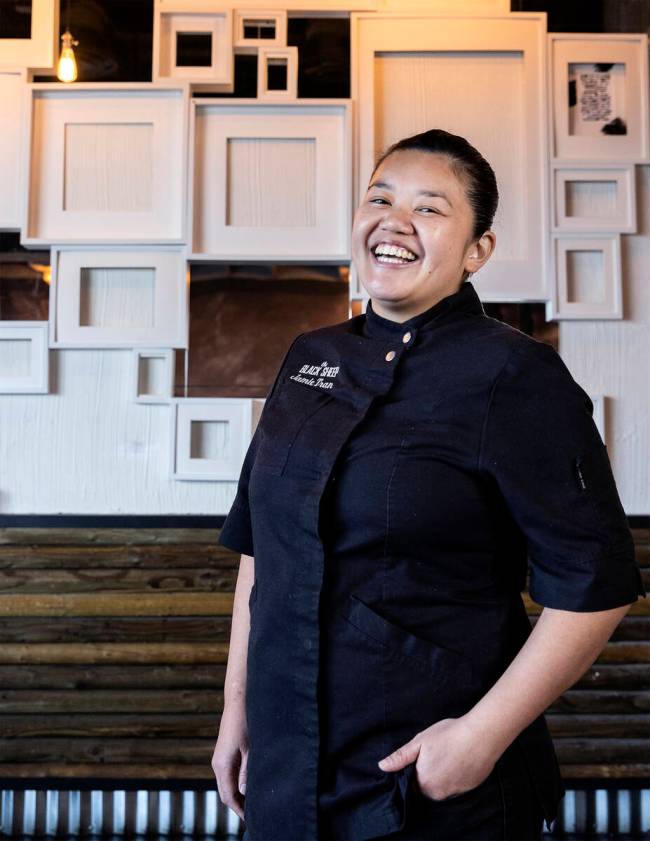
Wearing all the hats
The chef’s working the front of the house tonight.
Like expounding upon the joys of instant mashed potatoes, this is not the type of behavior that chefs typically engage in.
Nor is it something Tran ever really wanted to do.
Her father tried to get her to be a bus girl once.
That lasted two days.
“I hate standing there and I hate talking to people,” Tran recalls with the verbal equivalent of an eye roll.
But with her own place, she’s worked every position.
Part of it was out of necessity: When the pandemic hit, seating capacity was reduced and there were staffing shortages, so she had to learn how to do a little bit of everything, from operating the point-of-sale system to mixing drinks.
But it was also an effort to eradicate some of the barriers traditionally erected between the kitchen and those interacting with the customers.
“I never really understood what the servers went through, what the front of the house went through, or a hostess or a bar back or a bartender, until I had to work those positions,” Tran says. “Restaurants always have divisions between front and back of house, but I don’t like that, so I’ve been trying not to do that. I realized being an owner, you need to know everything.”
The pros of running your own place are that it can be a means of articulating your creative vision to a degree only possible when you’re calling all the shots.
The cons are that you are totally responsible for what that vision entails — right down to the plumbing.
James Trees says that he and Tran sometimes vent over the challenges of being independent restaurateurs without a hotel-casino’s army of support staff on speed dial.
“I needed Jamie in order to have those conversations that I couldn’t have with other chefs,” he says, “because they didn’t understand what it was like to be your own plumber, your own electrician, your own prep cook, your own equipment fixer, your own front-of-the-house, POS-solutions, IT desk.
“It’s very easy for chefs on the Strip to have all these different departments to be able to handle all these different things for them,” he continues. “When you know the ins and outs of your own plumbing system, because you’re an independent chef and you have to, that’s a different conversation that you really can’t share with someone on the Strip who just won’t understand it.”
Tran gets it, though.
She’s been there.
Before long, she’ll be there again, working behind the bar later tonight, pouring cocktails, all while hoping not to get noticed.
No such luck.
Minutes later, almost as if on cue, a lady with silver hair and a black dress, seated at the bar, recognizes her.
“There’s Jamie!” she observes excitedly.
“I haven’t seen her in years,” she notes. “Except on TV.”















